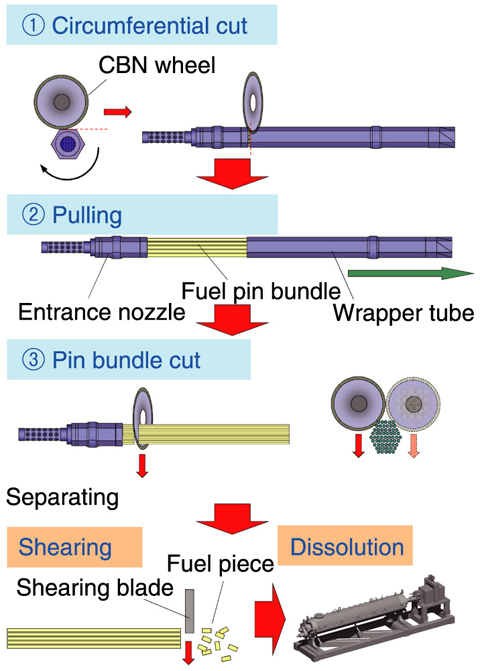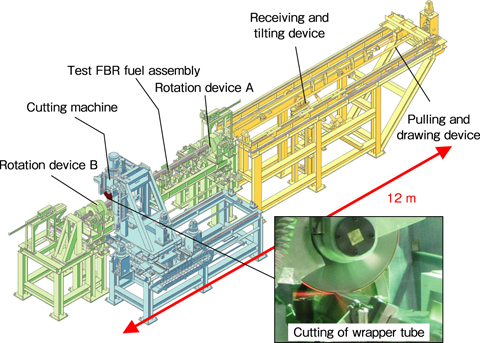
Fig.1-11 Disassembly procedures

Fig.1-12 Engineering-scale test machine for disassembly operation
FBR fuel pin bundles are arranged in a hexagonal-shaped wrapper tube, and thus the wrapper tube must be disassembled and separated from the fuel pin bundle before shearing. In this technology, the cutting performance is essential for disassembling the wrapper tube, which is made of stainless steel several millimeters thick, and the bundle, which includes a few hundred pins. Accurate control of the cutting depth is required in order not to damage the fuel pins, which are situated below 1 mm from the cutting point. In addition, the effects of irradiation deformation should be considered. Taking these conditions into account, we have developed a mechanical disassembly technology that combines cutting performance with cutting control.
A Cubic Boron Nitride (CBN) wheel was selected as desirable cutting tool. First of all, as shown in Fig.1-11, the wrapper tube is cut around the circumference and pulled from the fuel assembly. Here, if pulling the wrapper tube is not successful owing to the irradiation deformation, cutting toward pulling direction is performed. Next, by crop-cutting at the lower end plug, the fuel pins are separated from the entrance nozzle without being damaged, and they are then passed to the subsequent shearing stage.
We designed and fabricated an engineering-scale test device confirming the sequential disassembly operation using a mock-up fuel assembly (Fig.1-12). A cutting speed control system corresponding to the load on the cutting tool and a measurement system for the wrapper tube surface that takes the deformation into account were prepared in this device. From the test results, it was demonstrated that the cutting performance was good, the damage to the fuel pins was kept as low as possible, and the sequential operation of the overall disassembly procedure was successfully carried out.
In the near future, we will assess a number of points including radiation resistance and remote maintenance to construct a reliable system to be applied to the innovative FBR reprocessing plant.
This work is the result of the study “Developing Technologies for Disassembly and Pin Shearing of FR Spent Fuels, ” which was entrusted to The Japan Atomic Power Company (JAPC) by the Ministry of Education, Culture, Sports, Science and Technology of Japan (MEXT) in 2009.